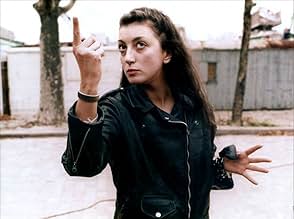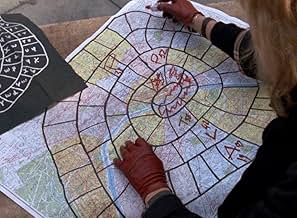CALIFICACIÓN DE IMDb
6.7/10
1.4 k
TU CALIFICACIÓN
Agrega una trama en tu idiomaYoung unhinged female ex-con with a motorcycle helps a sickly young homeless woman in red discover what the map of Paris she took from her gangster boyfriend leads to.Young unhinged female ex-con with a motorcycle helps a sickly young homeless woman in red discover what the map of Paris she took from her gangster boyfriend leads to.Young unhinged female ex-con with a motorcycle helps a sickly young homeless woman in red discover what the map of Paris she took from her gangster boyfriend leads to.
- Premios
- 1 nominación en total
Argumento
¿Sabías que…?
- TriviaMarie refers to the Game of the Goose (Jeu de l'oie), a french children's game that goes back to around 1597.
- ConexionesEdited into Paris s'en va (1981)
Opinión destacada
I saw this in memory of Jacques Rivette who passed away the other day, a wandering soul who paved the way for so many cinematic walks.
Here he retraces steps he had already taken before, two girls daydreaming a life of adventure around Paris in Celine and Julie, a grid of fictions and elusive conspiracy unfolding across the city as he favored since his very first. There are watchers throughout the city, a satchel full of newspaper clippings - stories within stories - and a map that points at symbolic reality.
The deliberate obliqueness - the daydreamed sense - is of course always Rivette's tool of suspending burdensome logic but we don't really cross beyond here to something alive, we spend a bit too much time stuck in the map. He traces these steps without the freshness of a first time, without making his way finally to a clearing that will open up a sense of meaningful horizon.
The part that captivates me is the one that echoes Celine and Julie. Two girls once more, one reading from a book and summoning the other, brash one as her fairy guide in a world of fictions and rituals, both of them lovely. It's the sense of reverie in the walking around; for Rivette - a cinematic flaneur - the city has to be walked in order to yield its insight. The insight is in the train tracks that lead out, atop the Arc, in the construction developments at the outskirts of Paris where, now at the outskirts of fiction, the world is a mass of gaping and colorless structures. It's one of the most roaming films.
The last scene is a container on its own right for Rivette's purpose and unlocks the whole; a mock karate fight where the opponent is unseen, there are set motions and steps to take, it accomplishes really nothing, except the fictional enactment loosens up the spontaneous experience of playing in this way, which can only take place because story has been exhausted and we have finally arrived at the end of the maze. Or is it the shape fiction takes when unburdened anymore by any plot about money? Or does it escape from the fact that someone has just been murdered? In the French semiotic sense these mean one and the same, layers of an onion.
Here he retraces steps he had already taken before, two girls daydreaming a life of adventure around Paris in Celine and Julie, a grid of fictions and elusive conspiracy unfolding across the city as he favored since his very first. There are watchers throughout the city, a satchel full of newspaper clippings - stories within stories - and a map that points at symbolic reality.
The deliberate obliqueness - the daydreamed sense - is of course always Rivette's tool of suspending burdensome logic but we don't really cross beyond here to something alive, we spend a bit too much time stuck in the map. He traces these steps without the freshness of a first time, without making his way finally to a clearing that will open up a sense of meaningful horizon.
The part that captivates me is the one that echoes Celine and Julie. Two girls once more, one reading from a book and summoning the other, brash one as her fairy guide in a world of fictions and rituals, both of them lovely. It's the sense of reverie in the walking around; for Rivette - a cinematic flaneur - the city has to be walked in order to yield its insight. The insight is in the train tracks that lead out, atop the Arc, in the construction developments at the outskirts of Paris where, now at the outskirts of fiction, the world is a mass of gaping and colorless structures. It's one of the most roaming films.
The last scene is a container on its own right for Rivette's purpose and unlocks the whole; a mock karate fight where the opponent is unseen, there are set motions and steps to take, it accomplishes really nothing, except the fictional enactment loosens up the spontaneous experience of playing in this way, which can only take place because story has been exhausted and we have finally arrived at the end of the maze. Or is it the shape fiction takes when unburdened anymore by any plot about money? Or does it escape from the fact that someone has just been murdered? In the French semiotic sense these mean one and the same, layers of an onion.
- chaos-rampant
- 29 ene 2016
- Enlace permanente
Selecciones populares
Inicia sesión para calificar y agrega a la lista de videos para obtener recomendaciones personalizadas
- How long is Le Pont du Nord?Con tecnología de Alexa
Detalles
Taquilla
- Total en EE. UU. y Canadá
- USD 17,110
- Fin de semana de estreno en EE. UU. y Canadá
- USD 5,333
- 24 mar 2013
- Total a nivel mundial
- USD 17,110
Contribuir a esta página
Sugiere una edición o agrega el contenido que falta

Principales brechas de datos
By what name was Le pont du Nord (1981) officially released in Canada in English?
Responda






















